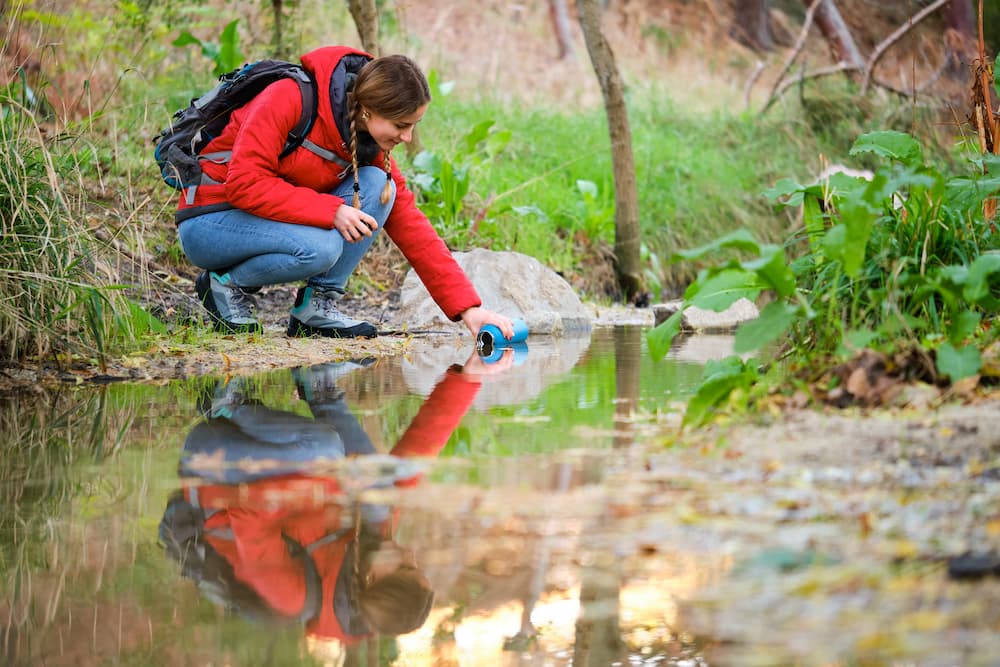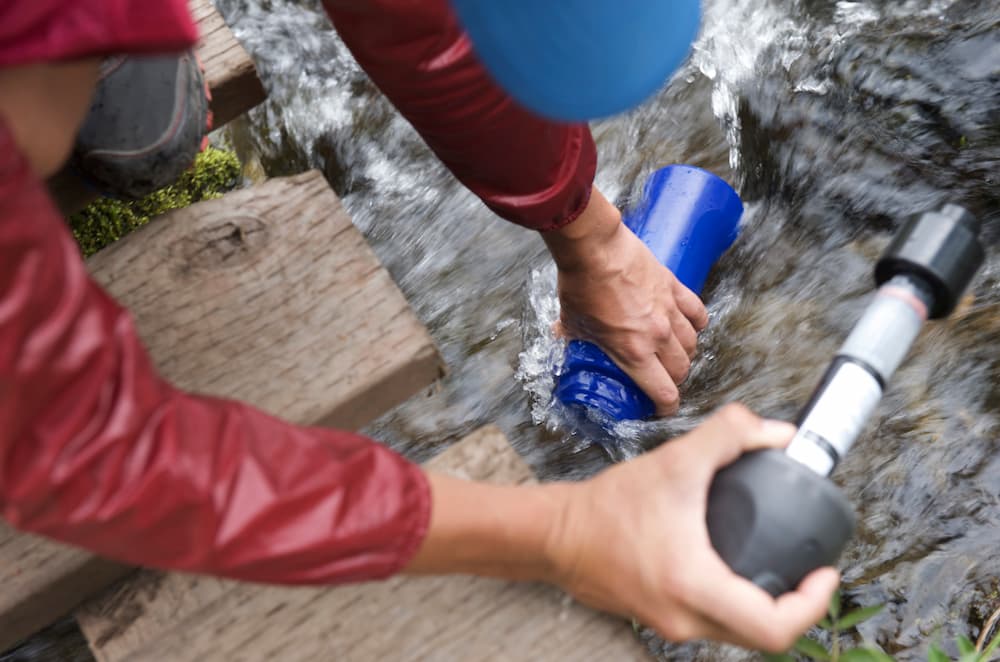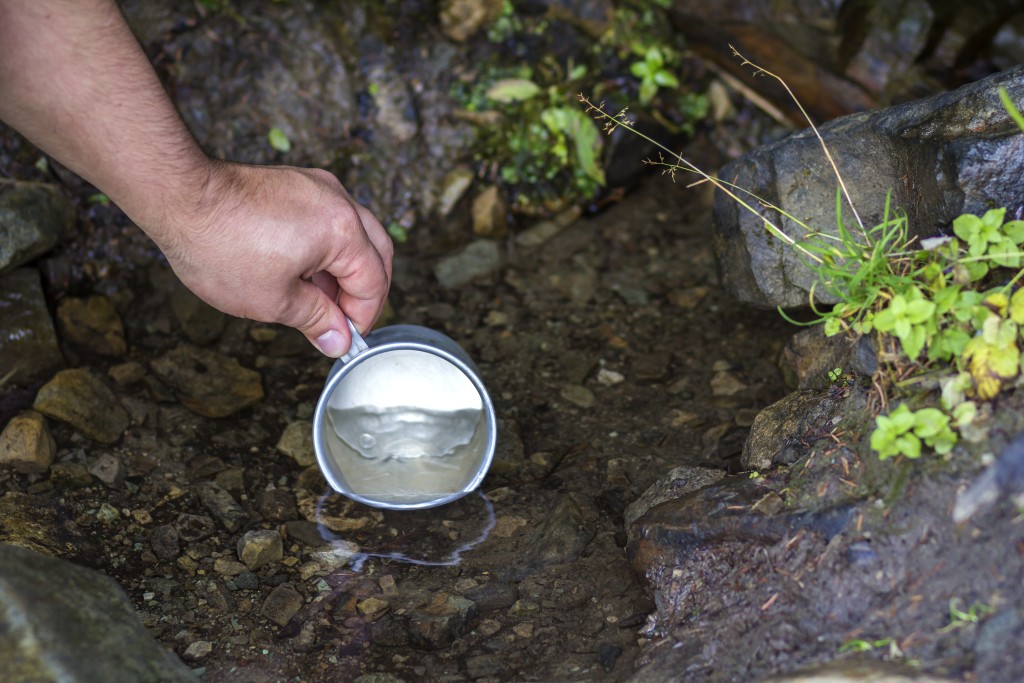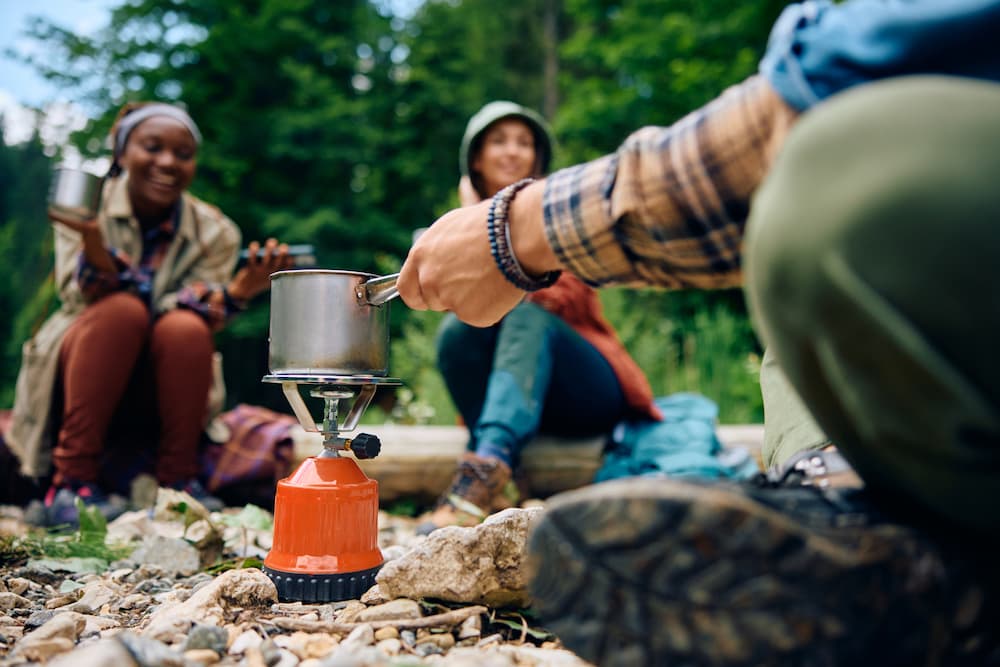
Water is HEAVY! A gallon weighs over 8 pounds. It’s often the heaviest thing in your pack when you’re hiking or backpacking. When you’re on an adventure that’s longer than a day or two, you won’t be able to carry enough water (and you definitely won’t want to!) That crystal-clear stream along the trail looks safe, but is it? Nope…it’s probably not. You’ll definitely need to purify the water.
When hiking or backpacking, having access to clean drinking water is non-negotiable. Even the clearest, coldest water can hide microscopic nasties that could leave you doubled over with stomach cramps instead of enjoying those epic views. Thankfully, it’s simple to purify water while you’re adventuring outdoors.
This guide is here to help you become a hydration hero! We’ll cover three tried-and-true water purifying methods and help you pick the best technique.
Why Treating Water is Non-Negotiable
Giardia (or as it’s playfully nicknamed, ‘Beaver Fever’) is a pesky protozoan that, along with bacteria and viruses, can lurk in untreated water. While your stream may look like something out of a fairy tale, invisible guests like E. coli, Cryptosporidium, and norovirus might also be along for the ride.
What does that mean for you? Symptoms like nausea, cramps, or diarrhea could hit and leave you miles from the closest trailhead. No thank you! Treating your water neutralizes these threats, keeping you safe and hydrated for the adventure ahead.
Finding Safe Water Sources
Before we even think about treating water, let’s talk about finding the safest stuff to start with. First off, go for flow! Fast-moving streams and rivers are way better than stagnant ponds or sketchy puddles. Nobody wants to drink muddy puddle soup! Also, head upstream whenever possible. The farther you go, the less likely the water’s been messed with by who-knows-what—or who-knows-who. And definitely avoid the obvious red flags like water hanging out near campsites, farms, or, yikes, visible animal poop. The goal is to make your water as clean as possible before you even begin treating it.
How Much Water Do I Need?
Figuring out how much water to carry depends quite a bit on the type of adventure you’re planning. For a day hike in moderate temperatures and with average effort, a good general guideline is to aim for about 0.5 liters to 1 liter of water per hour of hiking. So, for a two-hour stroll, maybe 1-2 liters is sufficient, but for a four-hour trek with some elevation change, you’re likely looking at 2-4 liters. Always consider the weather and how much you sweat—hot days or strenuous trails mean you’ll need more!
Now, if you’re heading out for a multi-day backpacking trip, the strategy changes entirely! You absolutely cannot carry all the water you’ll need for several days because it weighs too darn much. Instead, the plan is to carry enough water to safely get you from one reliable water source to the next. This often means having about 1-2 liters with you at any given time, though you might need to carry more if there are long stretches without water access.
💡 Tip: Always know your route and map out those water sources ahead of time! This helps you plan exactly how much water you need to carry between refill points, ensuring you stay safely hydrated throughout your adventure.
Purifying Water Method 1️⃣: Water Filtering

Water filters act like high-tech sieves, catching bacteria, protozoa, and bits of debris as the water passes through. They’re quick and straightforward to use, making them a favorite for hikers and backpackers.
Common Filter Types
- Squeeze Filters (like the Sawyer Squeeze): Lightweight and compact, ideal for solo hikers.
- Pump Filters: Great for groups, where the effort-reward ratio balances well.
- Gravity Filters: Hang, forget, and drink! These are perfect for a relaxing camp setup.
- Filter Straws (like LifeStraw): Simple, cost-effective, extremely lightweight. Perfect for emergencies or as a backup filtration system.
- UV Filters (like SteriPen): Use UV light to kill bacteria and viruses, works very quickly, but may not remove all contaminants.
✅ Pros
- Fast and effective against bacteria and protozoa.
- Removes visible gunk like grit or leaves (except for UV filters).
- Reliable with regular maintenance.
❌ Cons
- Most don’t remove viruses (though some advanced ones, like the LifeStraw, tackle this).
- Filters can clog or even break if they freeze in cold conditions.
💡 Quick Tips
- Never skip cleaning or backflushing your filter after use; it keeps things running smoothly.
- Keep your filter warm when temps drop by tucking it into your sleeping bag overnight.
Purifying Water Method 2️⃣: Chemical Treatment

Chemical treatments like Aquatabs kill the bad guys (bacteria, protozoa, and viruses) lurking in the water. These are a lifesaver if you’re traveling light.
✅ Pros
- Ultra lightweight and compact. Perfect for small packs and minimalist adventurers.
- Kills viruses, which filters may miss.
- Protects your water from recontamination for up to 24 hours in a closed container.
❌ Cons
- Requires waiting (typically 30 minutes or more).
- Doesn’t get rid of cloudiness.
- Might leave a slight aftertaste.
💡 Quick Tips
- If the water’s cloudy, pre-filter it through a bandana or coffee filter first for better results.
- Add a powdered drink mix if the “pool water” flavor bothers you!
Purifying Water Method 3️⃣: Boiling

Simply heat water to a rolling boil to kill bacteria, protozoa, and viruses. It’s reliable, straightforward, and effective, though it takes time.
✅ Pros
- The most thorough method out there.
- No special gear (besides a stove and pot) required.
❌ Cons
- Uses up valuable fuel.
- You have to wait for the water to cool before drinking.
- Not ideal if you’re on a tight schedule or far from camp.
💡 Quick Tips
- Boil water for at least 1 minute at sea level and 3 minutes if you’re above 6,500 feet in elevation.
- If this is your preferred method, try a Jetboil, which lets you boil water in less than two minutes!
Which Water Purification Method is Best?
Choosing the best water purification method really depends on your adventure and where you’re headed. First off, ask yourself, “Where am I hiking?” If you’re trekking through areas where viruses might be an issue—like tropical jungles or places with heavy foot traffic—filters alone might not cut it, and you’ll want to bring a purifier that tackles viruses. On the other hand, if you’re exploring pristine mountain streams, a basic filter could do the trick. It’s all about knowing the lay of the land and what kind of nasties might be lurking in the water.
Next, think about the length of your trip and the condition of the water. For longer adventures, backup options like purification tablets can be a lifesaver, especially if your primary method fails. And don’t forget to check out the water itself. If it’s cloudy or full of floaty bits, you’ll want to filter it first—not just because clear water looks more appetizing, but because it makes your treatment work better.
Try These Popular Combos for the Win!
- Filter + Tablets = Speed + Virus Protection.
- Tablet + Boiling = Lightweight + Backup for Emergencies.
Remember, always have a backup plan! Mother Nature throws curveballs, and having two methods available can save your adventure.
Be a Hydration Hero!
Treating water on the trail is a skill every outdoor enthusiast needs to master. It doesn’t just keep you safe; it gives you the confidence to explore farther and tap into your adventurous spirit. Before your next hike, practice these water purification methods at home, and pick your favorite method (and maybe try it with some coffee, because priorities).
What’s your go-to water treatment method? Got a funny or memorable trail story? Share your tips in our Facebook group and inspire someone else to get out there!

